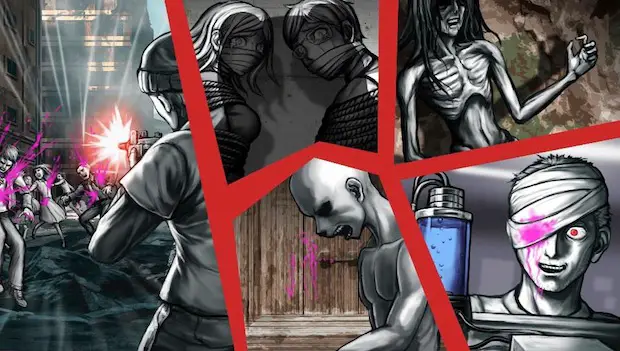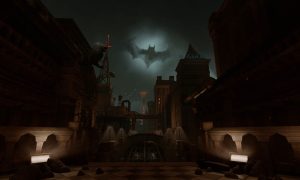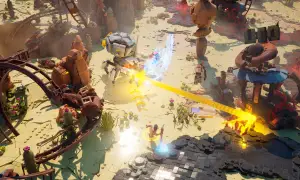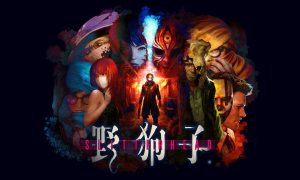[The following contains spoilers for Danganronpa: Trigger Happy Havoc and Danganronpa 2: Goodbye Despair, and is full of deep cuts regarding the series’ characters, world and story. Reader discretion is advised.]
I’ve played a lot of video games in my life. A lot. There are the ones that meant nothing to me, the ones that I remember with a half-hearted smile because that’s as much of a reaction as they were able to stir in me. But then there are some games that have left their mark. Typically it’s due to connections I made with the characters, but there are only a few games where the core of the plot has held a death grip on me that rivals that of the characters involved within.
Most recently, the game that has done that was Spike Chunsoft’s Danganronpa. As of the past few months, this series has absolutely taken over my head space. When the first game, Danganronpa: Trigger Happy Havoc, came out, I was captivated by its concept. The idea of a group of students locked in a high school and forced to kill each other in order to escape was mesmerizing, but I was still constantly moved by the power of its cast’s relationships. So when the game’s seemingly intimate and gritty premise became huge in scale in the end, I’ll admit that I was more than a little off-put. But when I finished Danganronpa 2: Goodbye Despair, I was completely engrossed in learning just how deep the rabbit hole went. I even raved about the game’s last few hours in my review of the game.
While the final chapters of both games are pretty much meant to act as an info dump, practically marking out various unresolved plot points as it goes, they still leave a lot up to the player’s interpretation and imagination. It’s the gaps I’m constantly filling in myself that makes the core of Danganronpa’s world more fascinating than the gut-wrenching murders and mind-boggling class trials. While on the surface Danganronpa sounds like a murder mystery with social sim elements, that is merely a cover for just how huge the scale of this misleadingly small setup is.
As protagonist Makoto Naegi and his classmates are locked away in Hope’s Peak Academy solving the mystery behind each other’s murders, outside the walls of the school something far more horrific is going on. The world is in chaos all thanks to a movement led by one within the game’s cast.
That movement is called Ultimate Despair, and the story of how this group of people came about proves to be the game’s greatest strength, as its actions are interwoven in everything that makes up Danganronpa.
If you ask what Ultimate Despair is, it probably doesn’t seem like as loaded of a question as it actually is. Nefarious organizations in video games can often be boiled down in pretty simple terms. Pokémon’s Team Rocket simply wishes to exploit Pokemon for profit, Kingdom Hearts’ Organization XIII is just concerned with the power of its leader, but Ultimate Despair’s singular purpose is meatier because of the people who make it up.

Ultimate Despair is described as despair made human, “utterly devoid of humanity.” Those who identify as part of it “don’t care about principles or morals. They just spread despair everywhere they go.” While the original Danganronpa’s murder mystery school life is going on, outside the world has been decimated by this group. They’re a terrorist group with only one singular goal: to spread despair across humanity, whether it be by murdering people outright, or by manipulating mankind’s final hope into killing each other.
Danganronpa’s murder mystery setting is one orchestrated by Ultimate Despair. The 15 students that appeared to be locked from the outside world and forced to kill each other were meant to act a symbol of hope for society, locked away in Hope’s Peak academy for their own protection. But through manipulation by Ultimate Despair and having their memories of what the organization had done removed, the group of students began killing each other in hopes of getting out.
The plan was elaborate, but it was only one of the many atrocities that Ultimate Despair committed.
As described at the end of Danganronpa 2, members of Ultimate Despair would starve themselves, kill their families or waves of innocents in order to feed off the despair of others.
But despite the name of the group, Ultimate Despair actually refers to one person in particular, the leader of the group, Junko Enoshima.
Junko Enoshima is the central character of the entire series. Once known as the Ultimate Fashionista within Hope’s Peak Academy, Junko slowly influenced the student body within the prestigious school. She’s the mastermind behind all the events of the first game.
What makes Junko such a spectacular villain is both her selfish motivations and her uncanny ability to manipulate those around her. Junko is like the extreme of a popular “queen bee” high school student. She’s charismatic, narcissistic and manages to pull others into her point of view so easily it’s as if it’s the symptom of a disease.
Why is she like this? Despair. It’s all that matters to her. She thrives on it. Craves it. Whether it’s hers or was brought upon others by her.
In layman’s terms, Junko values nothing. She says she’s bored of life, the world and even herself. She carries no hope within her and believes the world should feel the same way. Because she doesn’t want to feel anything else, it’s completely legitimate to call Junko’s love of despair a fetish. She even vocalizes it herself when she talks about murdering her sister Mukuro, who was disguised as her in the game’s first chapter.
“I knew you couldn’t be just some ordinary person. You’re some kind of…abnormality.” – Byakuya Togami
“Turning your own despair into some kind of fetish… Abnormality doesn’t even begin to describe it.” – Kyoko Kirigiri
Junko’s identity and role is kept a secret up until the game’s final hours, as she is the ultimate culprit behind the game’s murder mystery. As such, there’s not a lot of time to see just who she is, or just what a strong influence she was capable of, mainly by design. Junko’s goal at the point of her unmasking is not to exposition the reality of the cast’s situation, or even really interact with them in any substantial capacity at all. Junko doesn’t show up in the end to argue with the kids she put through Hell, she does it to talk to the audience who watched them slaughter each other. It’s here that Junko makes her last declaration of the power of Despair, not the movement she leads, but the idea behind everything she does.
What makes Junko’s appearance in Danganronpa: Trigger Happy Havoc so retroactively interesting is how she doesn’t really put too much importance on herself despite being the central figurehead of the entire movement. Junko presents herself as just another cog in the wheel. She isn’t interested in bringing attention to herself or taking credit for the destruction she’s caused, she wants to remind the world of the mindset behind the organization that leveled the world.

“For me, despair is not a goal, or a set of principles, or a lifestyle, or even an instinct. It’s what defines me as Junko Enoshima! It’s just my characterization! That’s why I’m able to pursue despair with such purity!” – Junko Enoshima
While Junko’s presence in the first Danganronpa game is grandiose and pretty abstract, in the second game we get a more personal view of her influence by seeing her interact (despite being dead after executing herself at the end of the first game) with people that she considered to be her followers.
Danganronpa 2: Goodbye Despair remakes the “killing game” scenario seen in Trigger Happy Havoc in a much different, and even more elaborate way. The 15 surviving members of Ultimate Despair are put into a virtual reality by an organization called the Future Foundation made up by the survivors of the first game. The virtual reality was meant to erase the members of Despair’s memories of Hope’s Peak Academy and Junko Enoshima in order to revert from their corrupted selves. Being so devoted to Junko and her own devotion to Despair, the group uploaded a virus into the system that would manipulate the mind-wiped kids into killing each other to escape a virtual island they were told was a prison.
As the members of Ultimate Despair began killing each other, the virus begins hacking into the system’s programming to allow an artificial intelligence made in Junko’s image to integrate into the bodies of the dead kids as if their new memories were being uploaded. Using the bodies of the deceased Ultimate Despair, Junko’s “Alter Ego” AI would take down the Future Foundation from the inside, including Trigger Happy Havoc’s cast who came into the simulation to save the members of Ultimate Despair.
The entire plan was orchestrated by the members of Ultimate Despair. They were willing to give their lives in order to please Junko, implying that they worshipped her in a way similar to a cult or an organized religion. Even still, Junko doesn’t seem to value the lives of her seemingly devout followers. Her Alter Ego calls them chumps, badgers and belittles them without missing a beat, and admits that they were nothing but tools to her from the start. This just further shows how indifferent Junko is to the lives of others. Even those who love her, she looks down upon.
But with the scale of this incident being relatively small, we do get to see Junko act more like an adversary to the first game’s main cast than she ever did when she was alive. Her banter with returning characters Makoto, Kyoko and Byakuya actually seems like rivals meeting again to settle a long unfinished battle.
Junko is a sociopath, but when she’s not pitching the idea of Despair, she’s funny, quick-witted and obviously intelligent. The way she talks around everyone with her silver tongue is bordering on captivating, and shows how powerful of an influence she can be through manipulating others, humiliating them or just lying to their face.
Because the cast is Ultimate Despair, we get the greatest glimpse as to what its members were like as we get to hear about it from the source’s mouth. Ultimate Despair’s most interesting aspect is that despite anyone considering themselves in allegiance with it, not everyone shares the same goals, motives or viewpoints.
As the truth of their existence is laid before them, members of Ultimate Despair are told of the various atrocities they committed, many of which do lead back to an idolizing of Junko, but sometimes it’s just a matter of feeling the same way about forcing their own misery onto the world.
Even with some characters having their own prerogative, Junko is present in the majority of their actions. After her death in the first game, members of Ultimate Despair began mass slaughtering of people, forcing them to commit suicide in her honor. Horrifyingly, some took Junko’s dead body and hacked it to pieces in order to transplant parts of her onto themselves, one even trying to use what was left of Junko to try and conceive her children.
But the biggest aftershock of Junko’s execution was the death of the members of Hope’s Peak Academy’s Reserve Course. Students at Hope’s Peak who that were not considered “Ultimate,” and had to pay their way in were part of the academy’s Reserve Course, who were manipulated into believing their money was being used to orchestrate an event that would go on to be called “The Tragedy,” a death match between the Ultimate students that were part of Hope’s Peak’s student council.
The Reserve Course students made up the majority of Ultimate Despair’s grunts, and after seeing their leader killed in a battle between Hope and Despair, all 2,357 members committed a mass suicide in a fit of hopelessness. And yet again, Junko’s Alter Ego expresses no remorse, only a fetishizing of the despair she’s caused.
Some members of Ultimate Despair proclaim their love of Junko outright. The most notable example of this was Mikan Tsumiki, the Ultimate Nurse. In Goodbye Despair, Mikan murdered two of her classmates after retrieving her lost memories of her time in Ultimate Despair. She claims to have killed in order to please her “beloved.”
As she waxes on about this mystery person, she talks about how they “forgave” her existence, and was the first person to truly treat her like a person instead of a nuisance. After the truth of these 15 student’s role in Ultimate Despair is revealed, it becomes obvious that the person that Mikan is referring to is none other than Junko Enoshima.

“My beloved…was the only one…That’s right, the only one…never hated me. They forgave my existence. They forgave me and accepted me. They gave me value. They loved me. I loved them with all my heart and they returned it in full. This is…my reciprocation.” – Mikan Tsumiki
Knowing this, it makes Mikan one of the most tragic figures in Danganronpa. When her memories of Junko’s acceptance are removed, she’s seen to be a socially inept young girl. She’s easily startled, stammers constantly and is always begging for forgiveness when bullied by the other students. However, when characters like Hajime Hinata and Chiaki Nanami are nice to her, she’s overjoyed at their acceptance. For what she believes is the first time in her life, she is making friends.
But in reality, the person that filled that role was Junko. Mikan undoubtedly had no reservations about becoming part of Ultimate Despair because Junko meant everything to her, even if the inverse wasn’t actually true.
On the completely opposite end of the spectrum is Nagito Komaeda. Within the simulation, Nagito believes in nothing but Hope. He offers to help others kill, or even kill him if it means they are doing it for the hope of escaping the island and returning to their life instead of out of malice, or worse, despair.
Unlike Mikan, Nagito’s motivations for becoming part of Ultimate Despair are the least obvious and have honestly been one of my biggest questions since finishing Danganronpa 2.
Nagito holds the distinction of being one of only two characters seen as Despair outside of the simulation, and what we see of the already frightening and ostensibly malicious character is pretty terrifying. In a flashback to before the members of Ultimate Despair were put inside the simulation, we see Nagito severed his arm and transplanted Junko’s onto his own body. The way he describes it is almost like he views it as a trophy. He claims to hate Junko with every fiber of his being, yet still he’s considered a member of the movement centered around her mindset.
“Then…will I be able to see her again? Will I be able to see the person I hate with every fiber of my being again? And this time…Will I be able to kill her this time? The person I hate so much?” – Nagito Komaeda

“…Isn’t it amazing? I can’t move it, of course. I mean, it’s not my hand after all! But…even now, it still hasn’t rotted…Hey, maybe that means it’s becoming one with me! Isn’t it amazing? I have successfully become one with Ultimate Despair, my sworn enemy!” – Nagito Komaeda
The fact that a person who was so immersed in the idea of Hope (even attempting to change his Ultimate Lucky Student title to Ultimate Hope like Trigger Happy Havoc’s Makoto Naegi) could fall under Junko’s influence shows not only the power of the Ultimate Fashionista’s charisma and manipulation, it also shows just how divided the members of Ultimate Despair are, and how a love of Junko isn’t necessarily a common thread. Nagito calls Junko his sworn enemy, and yet even as he says this, he doesn’t seem entirely confident in that declaration.
“I just see her as my enemy, you know. Because she’s my sworn enemy…because I hate her so much…That’s why I took her power. And for that I…Wait, huh? Do I…hate her? Huh…that’s strange…” – Nagito Komaeada
While Mikan is pretty straightforward and Nagito is a character pretty much made for speculation, there’s one character that truly underlines what it means to fall into Despair. Goodbye Despair’s protagonist Hajime Hinata emphasizes that the only requirement is to have your spirit broken to the point where you believe that thrusting despair upon others is only answer.
Hajime was a member of Hope’s Peak’s Reserve Course, meaning he was a guy wholly lacking in a talent that the academy recognized as Ultimate. Wanting to be able to believe in himself and carrying with him an unconditional admiration for the academy, Hajime agreed to be a subject of the institution’s Hope Cultivation Program. The program was Hope’s Peak Academy’s ultimate goal. It was meant to see if it was possible to artificially create talent in those who possessed none. Through directly altering Hajime’s brain, he became a genius whose Ultimate talent was talent itself. He would then be known as the hope for all of humanity. He was to be the Ultimate Hope.

The importance of the program led the staff of Hope’s Peak to call the newly reformed Hajime by the name of the academy’s founder, Izuru Kamukura. The cost of turning a talentless student like Hajime into the pinnacle of human talent was to essentially wipe away who he was before. His memories, feelings and beliefs were all eradicated in the process.
Hope’s Peak altered his mind without concern for what it would eventually turn Hajime into, and being her manipulative self, Junko exploited that by reminding Izuru of how the academy betrayed him until he eventually murdered Hope’s Peak’s student council during the Tragedy, which eventually lead to the uprising of the Reserve Course, and eventually Ultimate Despair’s reign of terror on society.
But what is the fate for one who identifies as Ultimate Despair? Should they be damned to death? Do they need to be put into a simulation that takes away their memories of when they were corrupted?
Is there hope for someone who claims to be the antithesis of the word?
The words “Hope” and “Despair” get thrown around so often in Danganronpa that it’s sometimes hard to pin down just what it’s referring to, but when it comes down to it, it becomes pretty literal when it really matters.
The one thing that can combat the influence of Junko’s despair is for one to find their own hope.
In the final hours of Danganronpa 2, the remaining survivors are told that in order to stop Junko’s Alter Ego from uploading into the bodies of their friends, they must shut down the program from the inside, while also preventing their memory-wiped avatars from uploading into their bodies. This means they will revert back to Ultimate Despair. Or, they can choose to complete the program and allow Junko’s plan to complete. They will lose their memories of being Ultimate Despair and be able to return to the real world having recovered from Junko’s manipulation.
The group finds themselves in a standstill, because they either hurt themselves or the rest of the world with whichever choice they pick. Both choices carry with them hope and despair. But while both Junko and Makoto are trying to make a case for the group to side with them, it ultimately becomes the group’s own hope that wins over what either party is trying to sell to them.
Junko’s despair takes shape because she doesn’t have any sort of positive view of the future. Hajime determines that if he is to defeat her, he must be able to look toward what comes next for him with a sense of purpose that is not for Makoto, but for himself. Though he feels regret for his past, what makes him different from Junko is that he believes that he has a future worth fighting for.
It’s not hope for the world, the Future Foundation or Junko’s twisted goals, it’s a hope for himself and the future he will shape all his own.

“We believe in our future…That’s what makes us different from you… We believe that if we try new things, even difficult things, that everything will turn out okay.” – Hajime Hinata
As the rest of the survivors are similarly resolved, Danganronpa once again sells the fact that, within its narrative, hope isn’t just some sort of buzzword it uses to represent the heroes of its story. It’s shown before in the end of the original game when the survivors are deciding between entering a world destroyed by Ultimate Despair and staying within the confines of Hope’s Peak Academy. Makoto tells his friends to not lose hope, but that isn’t just a blanket statement with the same meaning to everyone. Hina finds hope in carrying the torch for her fallen friends, Byakuya finds hope in his drive to bring glory to his family’s name in a time where he’s been told that it has been eviscerated.
While spreading despair is the elevator pitch of what Ultimate Despair is, Junko wanted to manipulate others into creating it while others had their own reasons. The concepts of Hope and Despair weren’t always portrayed in a way that really sold just how central they were to Danganronpa’s thematic makeup in the first game, but now that the second game has shown us first-hand just what it means to fall into Despair, it gives new meaning to both its enigma of a villain, and the bravery of those who defied and eventually overcame her.
Danganronpa’s murder mystery merely scratches the surface of its complex and multi-faceted narrative, all leading back to the influence of one charismatic Ultimate high school student.
There are games that I love more than Danganronpa, there are games that have affected me more than Danganronpa, but there has never been a game that I have felt so committed to sticking with through the long haul. I’ve never been more enthralled and invested in finding out the entirety of a story that has only been more powerful because of its ambiguity.
If this series can maintain this gripping narrative, I’m in this until the end. I will witness this ongoing battle between Hope and Despair as long as it can keep a hold on me, and if the trajectory of the story’s strength continues on this same path, that should be very easy for Spike Chunsoft to achieve.

“Man, this is absolute despair…I feel despair upon despair and despair toward despair yet again…How fun. Once you’ve experienced the despair I’ve suffered, there’s no turning back. Living in the shadows of past memories..That’s…too sad, you know…Ah, but I guess…I no longer… I no longer have to…hope for despair…That…is…just…so..hopeless…” – Junko Enoshima

See below for our list of partners and affiliates:


























